Abstract
Polyhydroxyalkanoates (PHAs) are aliphatic polyesters synthesized intracellularly by microorganisms as a carbon-storage substance. Among the various PHAs, 3-hydroxybutyrate (3HB)-based copolymers are crystalline polymers widely used as biodegradable plastics. Recently, PHAs containing α-carbon-methylated monomers, such as 3-hydroxy-2-methylbutyrate (3H2MB) and 3-hydroxy-2-methylvalerate (3H2MV), have been synthesized and characterized. However, a binary copolymer of 3HB and 3H2MV, P(3HB-co-3H2MV), had not yet been synthesized, and its material properties had not been investigated. In this study, P(3HB-co-11 mol% 3H2MV) (PHBMV11) was synthesized with recombinant Escherichia coli LSBJ, using trans-2-methyl-2-pentenoic acid as the 3H2MV precursor. The thermal properties of PHBMV11 were characterized using differential scanning calorimetry (DSC), and the results were compared with those of P(3HB-co-12 mol% 3-hydroxyvalerate) (PHBV12) to explore the effect of α-carbon methylation in the comonomer unit. PHBMV11 exhibited a higher enthalpy of fusion during the DSC heating process and higher crystallization temperature during the DSC cooling process than those of PHBV12. The half-crystallization time of PHBMV11 was slightly longer than that of the P(3HB) homopolymer and much shorter than that of PHBV12 previously reported. The α-carbon methylation of the 3H2MV unit also has a positive effect on the crystallization of 3HB-based copolymers, as the 3H2MB unit demonstrated previously.
1. Introduction
Polyhydroxyalkanoates (PHAs) are aliphatic polyesters synthesized intracellularly by microorganisms as carbon-storage substances [1,2,3]. Among PHAs, the homopolymer of (R)-3-hydroxybutyrate, [P(3HB) or PHB; (Figure 1)], is most commonly synthesized by microorganisms. P(3HB) shows excellent biodegradability in various environments such as compost, soil, river water, and seawater [4]. In addition, P(3HB) is hard, brittle, and exhibits poor flexibility because of its high crystallinity [1]. Therefore, 3HB-based copolymers such as poly(3HB-co-3-hydroxyvalerate) [P(3HB-co-3HV) or PHBV (Figure 1)] and poly(3HB-co-3-hydroxyhexanoate) [P(3HB-co-3HHx) or PHBH] have been recognized as practical materials [5].
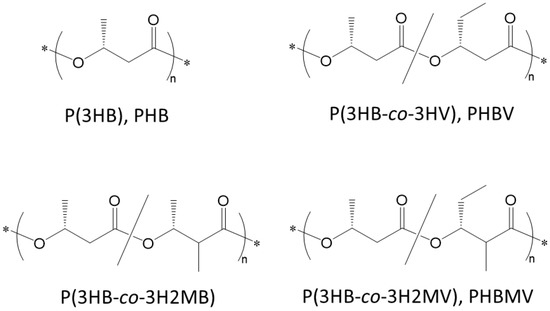
Figure 1.
Chemical structures of PHAs.
In recent years, Kaneka Corporation in Japan has developed a mass production process of PHBH by bacterial fermentation using plant oils as a raw material. This process can produce 5,000 tons per year and is scheduled to be scaled up to 20,000 tons in a few years [5]. The polymers are processed into marine degradable straws and cutlery and marketed in Japan. Although PHBH is a very practical material, some problems limit its widespread use. One of the problems is the slow crystallization behavior of PHBH. The 3HHx fraction in PHBH prevents the crystallization of polymers. For example, the half-crystallization time (t1/2) of PHB at 100 °C is 1.66 min, while the t1/2 of P(3HB-co-6 mol% 3HHx) at 90 °C is about 20 min [6]. This means that the time needed for PHBH to solidify after melting takes much longer than that of PHB. It is also the same problem for PHBV [7], which has been commercialized by Monsanto Company and others earlier than PHBH. Nucleating agents such as talc and boron nitride have been added to improve the crystallization of the polymer [7]. However, the slow crystallization of copolymers cannot be solved simply by applying nucleating agents. The development of PHA copolymers with excellent crystallization behavior will be important for the further development and commercial implementation of PHAs.
Differential scanning calorimetry (DSC) is a useful tool for evaluating the crystallization of polymers. During a DSC measurement, the cold-crystallization temperature (Tcc) detected during the 2nd heating process and the crystallization temperature (Tc) detected during the cooling process are important indicators and represent a proxy for the crystallization of the polymers. Additionally, the t1/2 observed during the isothermal crystallization of the polymers using DSC is also an important index for evaluating the crystallization behavior. These measurements open a window to evaluate the materials for potential commercial processibility before processing at scale.
The α-carbon-methylated monomer units, 3-hydroxy-2-methylbutyrate (3H2MB) and 3-hydroxy-2-methylvalerate (3H2MV) (Figure 1) have been detected as PHA components synthesized by microorganisms living in activated sludge from sewage treatment plants [8,9]. PHAs containing such α-carbon methylated units have great potential as novel bio-based materials. The 3H2MV repeating unit was detected more frequently than 3H2MB repeating unit in PHAs recovered from sludge bacteria when propionic acid was used as a feedstock [8,9]. These α-methylated monomers are presumed to be generated by the catalytic action of specific 3-ketothiolases [10], which are different from 3-ketothiolases (PhaAs) usually found in the typical PHA biosynthetic operon. However, the bacterial species capable of synthesizing α-methylated PHA have yet to be identified from activated sludge.
Recently, copolymers consisting of 3HB and α-methylated 3H2MB units, P(3HB-co-3H2MB) (Figure 1), were synthesized by recombinant Escherichia coli with an artificial metabolic pathway [11,12,13,14,15]. It was found that P(3HB-co-3H2MB) exhibits a different crystallization behavior from P(3HB) and the conventional 3HB-based copolymers due to the α-carbon-methylation of the 3H2MB unit. Particularly, P(3HB-co-3H2MB) showed a decreasing Tcc during the 2nd heating scan of the DSC measurement with increasing 3H2MB fraction up to 23 mol% [11]. This observation suggests that P(3HB-co-23 mol% 3H2MB) can crystallize faster than P(3HB) even at such a high 3H2MB fraction. In contrast, conventional 3HB-based copolymers, such as PHBV and PHBH, show increasing Tcc with increasing comonomer fractions [16,17]. Unlike P(3HB-co-3H2MB), the 3HB-based copolymers are less likely to crystallize as the comonomer content increases. This suggests incorporating these alternative monomer units into PHAs could lead to more industrially processable PHA polymers.
The 3H2MV unit has methyl- and ethyl side-chains at the α- and β-carbons, respectively. Due to the bulky ethyl side chain at the β-carbon, the 3H2MV unit can be expected to have different properties from the 3H2MB unit. However, the copolymers containing 3H2MV units synthesized thus far often contained 3HV and 3H2MB units other than 3HB units [8,9]. For such copolymers, the effects of 3H2MV on the properties of PHA could not be evaluated because 3HV and 3H2MB units shield the impact of the 3H2MV unit.
In this study, to evaluate the effect of the 3H2MV unit on the thermal and crystallization properties of the polymer, the binary copolymer P(3HB-co-3H2MV) was synthesized using recombinant E. coli LSBJ with trans-2-methyl-2-pentenoic acid as the 3H2MV precursor. The synthesized P(3HB-co-3H2MV) contained 11 mol% of 3H2MV, as revealed by 1H nuclear magnetic resonance (NMR) and was named PHBMV11. The thermal properties of this polymer were analyzed using DSC, and the results were compared with those of P(3HB) and P(3HB-co-12 mol% 3HV), which were named PHB and PHBV12, respectively. This study characterized the effect of α-methylated carbons of 3H2MV unit on the thermal and crystallization properties of 3HB-based copolymers.
2. Materials and Methods
2.1. Materials
trans-2-Methyl-2-pentenoic acid and trans-2-butenoic acid (crotonic acid) were purchased from the Tokyo Chemical Industry Co., Ltd. (Tokyo, Japan), and the pH of the fatty acid solutions were adjusted to 7.0–7.4 with NaOH solution. The PHB and PHBV12 powders were supplied by Monsanto Co., Ltd. (Saint Louis, MO, USA).
2.2. Bacterium Strain and Plasmids
The biosynthetic pathway for P(3HB-co-3H2MV) is shown in Figure 2. This biosynthetic strategy is similar to that reported in a previous study [13]. A mutant strain of E. coli LS5218 [fadR601, atoC(Con)] with fadB fadJ double deletion, namely, E. coli LSBJ [18,19], was selected as the host strain for PHA accumulation. E. coli LSBJ harboring plasmids pBBR1phaP(D4N)CJAcNSDG and pTTQ19-PCT have been cultured [13,14]. The plasmid pBBR1phaP(D4N)CJAcNSDG harbors Aeromonas caviae PHA-granule-associated protein gene (phaPAc) with a D4N point mutation [20], A. caviae PhaC gene (phaCAcNSDG) with N149S and D171G point mutations [21,22], and A. caviae (R)-specific enoyl-CoA hydratase gene (phaJAc). The plasmid pTTQ19-PCT [14,23] carries the PCT gene (pct) from Megasphaera elsdenii for trans-2-methyl-2-pentenoyl-CoA and crotonyl-CoA supplementation.
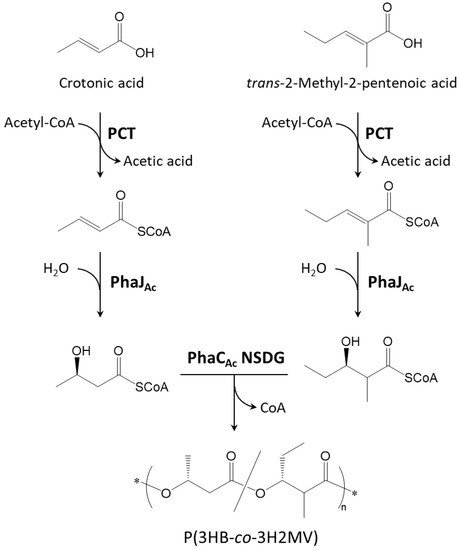
Figure 2.
The metabolic pathway for P(3HB-co-3H2MV) synthesis constructed in E. coli LSBJ.
2.3. Biosynthesis of PHA
The recombinant E. coli LSBJ strain was cultivated in Luria–Bertani (LB) medium (10 g NaCl, 10 g tryptone, and 5 g yeast extract per liter of water) with 50 mg/L kanamycin and 50 mg/L carbenicillin at 30 °C for 15 h as a seed culture.
A two-step culture strategy was used for the PHA synthesis. To obtain PHA-free cells, 10 mL of pre-culture was added to 1 L (final volume) of LB medium in 2 L shake flasks containing 50 mg/L kanamycin and 50 mg/L carbenicillin. After 15 h of incubation at 30 °C, the cells were collected by centrifugation (4137× g, 8 min, room temperature) and washed with saline water. Subsequently, as a second step to synthesize P(3HB-co-3H2MV) copolymer, the cells were transferred into 1 L of the M9 modified medium (17.1 g/L Na2HPO4·12H2O, 3 g/L KH2PO4, 0.5 g/L NaCl, 2 mL of 1 M MgSO4·7H2O, 0.1 mL of 1 M CaCl2, and 2.5 g/L Bacto-yeast extract) [13,14] in 2 L shake flasks containing 50 mg/L kanamycin and 50 mg/L carbenicillin. trans-2-Methyl-2-pentenoic acid and crotonic acid, previously converted to sodium salts as described above, were used as precursors for 3H2MV and 3HB, respectively. A total of 7.5 g/L glucose (1.25 g/L each time at 0, 12, 24, 36, 48, and 60 h), 1 g/L trans-2-methyl-2-pentenoic acid (at 0 h), and 0.2 g/L crotonic acid (at 0 h) were added to the culture medium. Shake flask cultivation was performed at 100 rpm and 30 °C for 72 h.
2.4. Gas Chromatography Analysis
The polymer content of the dried cells was determined by gas chromatography (GC) using a Shimadzu GC-2014s chromatograph equipped with a flame-ionization detector. Approximately 20 mg of lyophilized cells were weighed and methanolyzed using sulfuric acid and methanol (sulfuric acid/methanol = 15:85, v/v) at 100 °C for 8 h. The samples were injected through the GC capillary column InertCap 1 (30 m × 0.25 mm, GL Science, Tokyo, Japan). The column temperature was initially set at 90 °C for 2 min, increased to 110 °C at a rate of 5 °C/min, and then increased to 280 °C at a rate of 20 °C/min [14,15].
2.5. Polymer Extraction and Purification
Polymers were extracted from the lyophilized cells using chloroform (1 mg PHA:2 mL chloroform) at room temperature for three days. The cell residue was filtered, and the resulting polymer solution was purified by reprecipitation in methanol. The polymers were collected using filter papers, dried, dissolved in chloroform, and reprecipitated in hexane. Finally, the collected polymers were dissolved in chloroform and reprecipitated from methanol.
2.6. Molecular Weight Analysis
The molecular weights of the PHA samples were determined via gel-permeation chromatography (GPC) using a Shimadzu Nexera 40 GPC system (Kyoto, Japan) equipped with a Shodex RI-504 refractive-index detector (Tokyo, Japan). Approximately 2–3 mg of the purified polymer was weighed into a 5 mL vial and dissolved in chloroform to a concentration of 1 mg/mL. GPC analysis was performed using two KF-406LHQ-joined columns (Shodex, Tokyo, Japan) at a column-oven temperature of 40 °C. Calibration curves were plotted using polystyrene standards with low polydispersity.
2.7. NMR Analysis
The microstructures and monomer compositions of the biosynthesized PHAs were analyzed by NMR spectroscopy using a BioSpin Avance III 400 A spectrometer (Bruker, Billerica, MA, USA). The 400 MHz 1H NMR and 100 MHz 13C NMR spectroscopic analyses were performed on approximately 10–15 mg of purified polymer samples dissolved in 1 mL of deuterated chloroform. The PHA monomer composition was determined by calculating the ratio of the peak areas of the methine region in the NMR spectrum.
2.8. Thermal Property Analysis
The melting and crystallization behaviors of the PHA samples were analyzed using DSC 8500 (Perkin–Elmer, Waltham, MA, USA) under a helium atmosphere. Approximately 5–10 mg of each PHA sample was weighed and sealed in an aluminium pan. The temperature program was started by holding the samples at −50 °C for 2 min, followed by an increase in the temperature up to 200 °C, at a heating rate of 10 °C/min (first heating scan), holding the samples at 200 °C for 2 min, and then rapidly decreasing the temperature to −50 °C at a cooling rate of 500 °C/min; held at −50 °C for 2 min; and then increased again to 200 °C at a heating rate of 10 °C/min (second heating scan); held at 200 °C for 2 min; then decreased to −50 °C at a heating rate of 10 °C/min (cooling scan). The original melting temperature (Tm) and the enthalpy of fusion (ΔHm) were determined from the first DSC heating scan. The glass-transition temperature (Tg), Tcc, and enthalpy of cold crystallization (ΔHcc) were determined from the second heating scan. The Tc and enthalpy of crystallization (ΔHc) were determined from the cooling scans.
The t1/2 of the samples was determined by isothermal crystallization analysis using DSC. The polymer was heated at 200 °C and then quenched to the isothermal-crystallization temperature, followed by the measurement of the exothermal heat flow, and t1/2 was determined based on Avrami kinetics.
3. Results
3.1. Biosynthesis of PHA by Two-Step Cultivation
First, we synthesized the P(3HB-co-3H2MV) copolymer using recombinant E. coli LSBJ in a one-step cultivation with trans-2-methyl-2-pentenoic acid and crotonic acid as the precursors for 3H2MV and 3HB, respectively. However, these organic acids strongly inhibited cell growth, and a sufficient number of cells could not be obtained (only up to 0.7 g/L of dry cell weight could be recovered). Thus, we employed a two-step cultivation strategy to enhance the cell yield. In the two-step cultivation, the dry cell weight increased up to 2.1 g/L. Additionally, the cells accumulated 5.5 wt.% of PHA. Approximately 30 mg PHA was obtained by repeating the two-step cultivation and polymer purification. The number-average molecular weight (Mn) and polydispersity (PDI) of this polymer were 19.2 × 105 and 1.22, respectively (Table 1). This polymer was used for further analysis.

Table 1.
Molecular weights and thermal properties of PHAs used in this study.
3.2. NMR Analysis of Biosynthesized PHA
The 400 MHz 1H NMR analysis was performed to study the polymer samples’ monomer compositions and compositional distributions. Figure 3 shows each proton resonance assignment for the P(3HB-co-3H2MV) copolymer [8], where signals 2 and 5 were chosen to calculate the fractions of 3HB and 3H2MV units based on their peak intensities. These two signals were selected because each was recognizable in the spectra. The 3H2MV fraction determined by 1H NMR was 11 mol%.
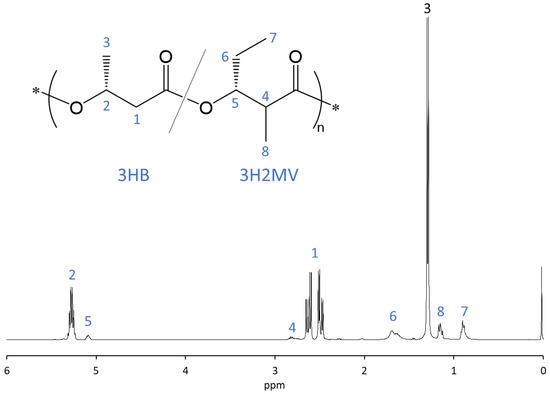
Figure 3.
1H NMR spectrum of P(3HB-co-11 mol% 3H2MV) (PHBMV11).
The monomer sequence distribution of PHBMV11 was studied to determine whether it is a statistically random copolymer. Based on the Bernoulli distribution, there are FB*-B, FB*-V, FV*-B, and FV*-V (B and V represent 3HB and 3H2MV, respectively). FX*-Y is the mole fraction of the XY distribution, and the parameter D is used to calculate the randomness of the copolymer, which is defined as follows [24]:
Theoretically, the D value of a statistically random copolymer is 1. Blocky copolymers have D values much higher than 1, whereas alternating copolymers have D values close to 0 [24]. The D value was calculated for PHBMV11 using the carbonyl peaks detected in the 13C NMR spectrum (Figure 4). The D value of PHBMV11 was 3.85, indicating a slightly blocky copolymer. However, this blockiness is commonly observed in biosynthesized PHAs [24,25]. The same analysis was applied to the PHBV12 obtained from the Monsanto Company, and the D value was determined to be 1.40.

Figure 4.
13C NMR spectrum of P(3HB-co-11 mol% 3H2MV) (PHBMV11).
3.3. Thermal Properties of PHA
The melting and crystallization behaviors of PHBMV11 were determined using DSC and compared with those of PHB and PHBV12. The results are presented in Figure 5 and Table 1. In the DSC’s first heating scan, PHBMV11 showed Tm at 162 and 176 °C, higher than PHBV12 (at 139 and 157 °C). Furthermore, ΔHm of PHBMV11 determined from the 1st heating scan was 44.5 J/g, which is also much higher than that of PHBV12 (27.3 J/g). On the other hand, the Tm of PHB was detected at 186 °C, and the ΔHm was 84.8 J/g. The Tm of PHBMV11 is only 10 °C lower than that of PHB, but the degree of crystallinity is expected to be much lower than PHB.
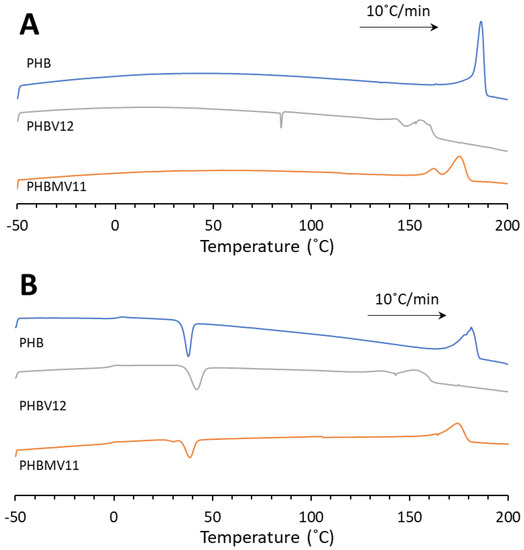
Figure 5.
DSC thermograms of P(3HB-co-11 mol% 3H2MV) (PHBMV11), P(3HB-co-12 mol% 3HV) (PHBV12), and P(3HB) (PHB). (A) first heating scan, (B) second heating scan.
In DSC second heating scan, Tgs of PHBMV11 and PHBV12 were detected at −2.8 and 3.7 °C, respectively. Tcc detected for PHBMV11 was 39.3 °C, which is close to that of PHB (37.8 °C), suggesting that, despite being a copolymer, PHBMV11 exhibits a crystallization behavior similar to PHB homopolymer rather than PHBV12.
To further investigate the crystallization behavior, crystallization during the cooling process was investigated (Figure 6). A higher Tc detected during the DSC cooling process indicates that the polymer is more likely to crystallize. Tc values for PHB, PHBV12, and PHBMV11 were detected at 86.5, 53.5, and 72.2 °C, respectively. Based on this observation, PHB exhibited the fastest crystal formation, followed by PHBMV11 and PHBV12. This order was the same as that of ΔHc. Although PHBMV11 and PHBV12 had similar comonomer compositions, there was a considerable difference in crystallization behavior due to the α-carbon-methylation.
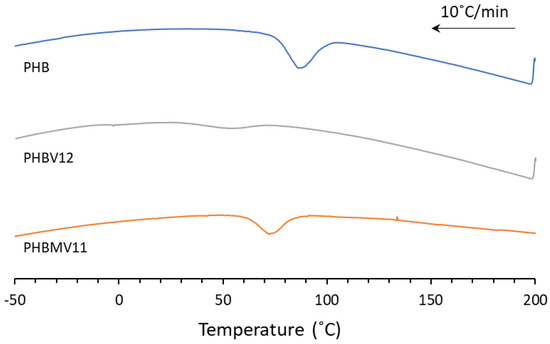
Figure 6.
DSC thermograms during cooling process of P(3HB-co-11 mol% 3H2MV) (PHBMV11), P(3HB-co-12 mol% 3HV) (PHBV12), and P(3HB) (PHB).
3.4. Isothermal Crystallization of PHA
The crystallization rate of PHBMV11 was evaluated by determining t1/2 in isothermal crystallization in the temperature range from 75 °C to 105 °C. The results are shown in Figure 7. The t1/2 was 1.56 min at an isothermal crystallization temperature of 75 °C, and the t1/2 became longer as the temperature increased. PHB generally exhibits the shortest t1/2 at around 60–70 °C. The t1/2 of PHBMV11 was longer than that of PHB in any temperature range tested (Figure 7), indicating slower crystallization than PHB, which is consistent with the results of non-isothermal crystallization (Figure 6).
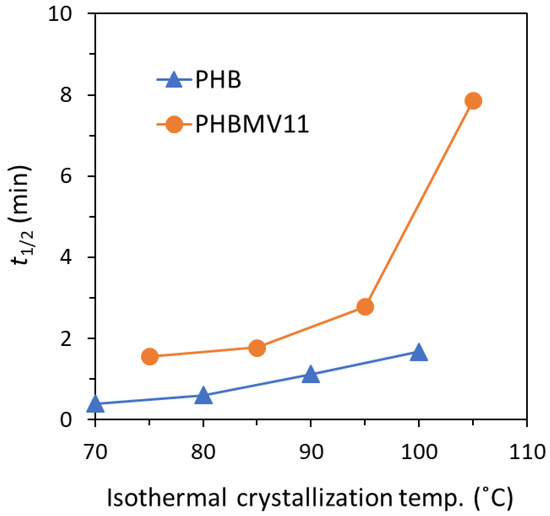
Figure 7.
Half-crystallization time (t1/2) in isothermal crystallization of P(3HB-co-11 mol% 3H2MV) (PHBMV11) and P(3HB) (PHB) [12]. The t1/2 of PHBV12 at 80 °C was reported as 39.05 min [26].
On the other hand, the half-crystallization time of PHBV12 was very long compared to those of PHB and PHBMV11. Therefore, we were unable to get a reliable result in this study. According to a previous study, the half-crystallization time of PHBV12 at 80 °C was reported as 39.05 min [26]. Taken together, these results suggest that the crystallization behavior of PHBMV11 is relatively similar to that of PHB as opposed to the crystallization behavior of PHBV12, owing to the effect of α-carbon-methylation.
4. Discussion
PHAs containing α-carbon methylated monomer units are a new class of bio-based materials with novel properties. α-Methylated PHA has been found in activated sludge from sewage treatment plants [8,9], but the microorganisms that synthesize α-methylated PHA have not been elucidated. Recently, it became possible to synthesize various α-methylated PHAs using genetically modified E. coli LSBJ with an artificial metabolic pathway and precursors of α-methylated monomers [11,12,13,14,15]. This has allowed for the synthesis of PHAs containing 3H2MB and their thermal and mechanical properties to be characterized. On the other hand, the precursor of 3H2MV can be acquired as a commercially available reagent, and it seemed possible to synthesize 3H2MV-containing PHAs using a similar synthetic strategy as was used for PHAs containing 3H2MB repeating units [12,13]. However, the 3H2MV precursor, trans-2-methyl-2-pentenoic acid, was found to retard the growth of the bacterial cells, which ultimately resulted in a low PHA yield. Therefore, we tried to reduce the apparent cytotoxicity of the 3H2MV precursor by adopting a two-step culture method.
To evaluate the effect of the 3H2MV unit on the thermal and crystallization properties of the polymer, the production of a binary copolymer P(3HB-co-3H2MV) was needed. In this study, P(3HB-co-3H2MV) was synthesized, aiming to incorporate a 3H2MV fraction of about 12 mol%. The reasoning was to compare P(3HB-co-3H2MV)'s thermal and crystallization properties with those of PHBV12 obtained from Monsanto Company. Previous studies have reported that PHBV12 exhibits much slower crystallization than PHB [7,26]. As the result of the biosynthesis study, we successfully obtained P(3HB-co-3H2MV) containing 11 mol% of 3H2MV unit, comparable to PHBV12 in copolymer composition.
On the other hand, it was challenging to produce polymers with similar molecular weights and randomness via biosynthesis. In general, the lower the molecular weight and the lower the randomness of the copolymer (the D value is far from 1), the easier the polymers crystallize [17]. As for PHBMV11, the Mn is as high as 19.2 × 105. In addition, the D value of PHBMV11 was 3.85, indicative of a slightly blocky copolymer, but such D values are often observed for biosynthesized PHAs [17,25]. Nevertheless, PHBMV11 exhibited a higher crystallization temperature during the DSC cooling process (Figure 6) and a much shorter half-crystallization time (Figure 7) when compared to PHBV12. Therefore, we consider that the differences in molecular weight and the randomness of the copolymer are unlikely to have a large effect on the crystallization behavior. It was concluded that PHBMV11 is easier to crystallize than PHBV12, even considering such differences in sample properties.
The effect of the 3H2MV unit to promote crystallization is probably due to the promotion of crystal nucleation, similar to how the 3H2MB unit promotes crystallization, as previously demonstrated [11,12,13]. In the case of P(3H2MB), the primary nucleation rate was approximately 200-fold higher than that of P(3HB) [12]. Therefore, P(3H2MB) had numerous fine spherulites, unlike P(3HB), which had some large spherulites. In contrast to the 3H2MB unit, the ability of the 3H2MV unit to promote crystal nucleation would be weaker than that of the 3H2MB unit because of the bulky ethyl side chain at the β-position.
The stereoregularity of the 3H2MV unit should be considered. The 3H2MV unit is thought to exist in four isomeric forms derived from the α- and β-carbon chirality. The β-carbon is assumed to be the (3R) enantiomer, judging from the substrate specificity of PHA synthase. No PHA synthase polymerizes the (3S) enantiomer monomer units. The chirality of the α-carbon is currently unknown. However, the previous study on P(3H2MB) suggested the possibility that the 3H2MB unit polymerized into PHA is a (2R,3R) enantiomer based on optical rotation measurements [12]. Thus, it is highly likely that the 3H2MV unit in this study is also the (2R,3R) enantiomer because the same synthetic strategy was employed except for the precursor. Meanwhile, PHA synthases are expected to polymerize both (2R)- and (2S)-enantiomers, which can be inferred from the fact that 3-hydroxypivalate, an α,α-disubstituted monomer unit, can be polymerized [15]. Therefore, the stereoregularity control of the 3H2MV unit is of great interest to further alter the property of PHA.
The α-methylated PHAs have recently attracted much attention as a new recyclable and sustainable high-performance polymer [27,28]. The α-methylated PHAs tend to have high melting temperatures and excellent mechanical properties. In the case of P(3H2MB), Tm and Tg are 196 °C and 15 °C, respectively, both of which are about 10–15 °C higher than those of non-α-methylated P(3HB) [12]. The elongation at break of P(3HB) is 12%, while that of P(3H2MB) shows a significant increase to 520% [12]. Furthermore, controlling the cis/trans ratio of the 3H2MB repeating units by chemical synthesis allows for the developing of high-melting, thermally stable, and mechanically tough copolymers covering a full range of polyolefin-like properties [27]. Moreover, Zhou et al. reported that replacing reactive carbonyl-adjacent hydrogens in the monomer with methyl groups produces a PHA that addresses the origin of thermal instability by precluding facile cis-elimination during thermal degradation [28]. Thus, the α,α-disubstitution in PHAs enhances thermal stability so substantially that the PHAs become melt-processable [28]. Accordingly, methyl groups at the α-position significantly improve PHA in multiple respects. Therefore, the 3H2MV unit, a repeating unit characterized in this study, will also contribute to the diversification of α-methylated PHAs as a newly available monomer.
5. Conclusions
A binary copolymer, P(3HB-co-3H2MV), was synthesized with recombinant E. coli LSBJ using crotonic acid and trans-2-methyl-2-pentenoic acid as 3HB and 3H2MV precursors. The obtained copolymer, PHBMV11, consisted of an 11 mol% 3H2MV unit, as revealed by 1H NMR analysis. The thermal properties of PHBMV11 were compared with those of PHB and PHBV12. Due to the effect of α-methylated-carbon of the 3H2MV unit, the crystallization of PHBMV11 progresses more easily than that of PHBV12. This is based on the facts that the Tcc of PHBMV11 was detected at a lower temperature than that of PHBV12 in the DSC 2nd heating scan and that the Tc of PHBMV11 was detected at a higher temperature than that of PHBV12 in the DSC cooling process.
Additionally, the t1/2 of PHBMV11 was much shorter than that of PHBV12 previously reported and slightly longer than that of the P(3HB) homopolymer. This means that the solidification of PHBMV11 after melting takes a much shorter time than that of PHBV12 and is comparable to that of PHB. Thus, this study confirmed that the 3H2MV unit in PHBMV11 promotes crystallization, probably due to the promotion of crystal nucleation similar to the manner observed when PHA copolymers incorporate 3H2MB repeating units.
Author Contributions
Conceptualization, T.N. and T.T.; methodology, Y.M., T.N., M.M., Z.Q. and T.S.; validation, Y.M., T.N., M.M. and Z.Q.; formal analysis, Y.M., T.N., M.M. and Z.Q.; investigation, T.N., M.M. and Z.Q.; resources, C.T.N., S.T., H.A. and T.T.; data curation, Y.M., T.N. and Z.Q.; writing—original draft preparation, Y.M., C.T.N. and T.T.; writing—review and editing, T.T.; visualization, Y.M., T.N. and T.T.; supervision, T.T.; project administration, T.T.; funding acquisition, T.T. All authors have read and agreed to the published version of the manuscript.
Funding
This research was funded by JSPS KAKENHI, grant Number: 21H03640 (to T.T.).
Data Availability Statement
Not applicable.
Acknowledgments
The authors gratefully acknowledge the Materials Analysis Division, Open Facility Center, Tokyo Institute of Technology, for supporting NMR measurements.
Conflicts of Interest
The authors declare no conflict of interest.
References
- Sudesh, K.; Abe, H.; Doi, Y. Synthesis, structure and properties of polyhydroxyalkanoates: Biological polyesters. Prog. Polym. Sci. 2000, 25, 1503–1555. [Google Scholar] [CrossRef]
- Chen, G.Q.; Hajnal, I.; Wu, H.; Lv, L.; Ye, J. Engineering biosynthesis mechanisms for diversifying polyhydroxyalkanoates. Trends Biotechnol. 2015, 33, 565–574. [Google Scholar] [CrossRef] [PubMed]
- Tsuge, T. Metabolic improvements and use of inexpensive carbon sources in microbial production of polyhydroxyalkanoates. J. Biosci. Bioeng. 2002, 94, 579–584. [Google Scholar] [CrossRef] [PubMed]
- Suzuki, M.; Tachibana, Y.; Kasuya, K.I. Biodegradability of poly(3-hydroxyalkanoate) and poly(ε-caprolactone) via biological carbon cycles in marine environments. Polym. J. 2021, 53, 47–66. [Google Scholar] [CrossRef]
- Choi, S.Y.; Cho, I.J.; Lee, Y.; Kim, Y.-J.; Kim, K.-J.; Lee, S.Y. Microbial polyhydroxyalkanoates and nonnatural polyesters. Adv. Mater. 2020, 32, 1907138. [Google Scholar] [CrossRef] [PubMed]
- Jonnalagadda, D.; Kuboki, T. Effect of natural flours on crystallization behaviors of poly(3-hydroxybutyrate-co-3-hydroxyhexanoate). J. Appl. Polym. Sci. 2016, 133, 43600. [Google Scholar] [CrossRef]
- Kai, W.; He, Y.; Inoue, Y. Fast crystallization of poly(3-hydroxybutyrate) and poly(3-hydroxybutyrate-co-3-hydroxyvalerate) with talc and boron nitride as nucleating agents. Polym. Int. 2005, 54, 780–789. [Google Scholar] [CrossRef]
- Inoue, Y.; Sano, F.; Nakamura, K.; Yoshie, N.; Saito, Y.; Satoh, H.; Mino, T.; Matsuo, T.; Doi, Y. Microstructure of copoly(3-hydroxyalkanoates) produced in the anaerobic–aerobic activated sludge process. Polym. Int. 1996, 39, 183–189. [Google Scholar] [CrossRef]
- Dai, Y.; Lambert, L.; Yuan, Z.; Keller, J. Characterization of polyhydroxyalkanoate copolymer with controllable four-monomer composition. J. Biotechnol. 2008, 134, 137–145. [Google Scholar] [CrossRef]
- Dong, H.; Liffland, S.; Hillmyer, M.A.; Chang, M.C.Y. Engineering in vivo production of α-branched polyesters. J. Am. Chem. Soc. 2019, 141, 16877–16883. [Google Scholar] [CrossRef]
- Watanabe, Y.; Ishizuka, K.; Furutate, S.; Abe, H.; Tsuge, T. Biosynthesis and characterization of novel poly(3-hydroxybutyrate-co-3-hydroxy-2-methylbutyrate): Thermal behavior associated with α-carbon methylation. RSC Adv. 2015, 5, 58679. [Google Scholar] [CrossRef]
- Furutate, S.; Kamoi, J.; Nomura, C.T.; Taguchi, S.; Abe, H.; Tsuge, T. Superior thermal stability and fast crystallization behavior of a novel, biodegradable α-methylated bacterial polyester. NPG Asia Mater. 2021, 13, 31. [Google Scholar] [CrossRef]
- Furutate, S.; Abe, H.; Tsuge, T. Thermal properties of poly(3-hydroxy-2-methylbutyrate-co-3-hydroxybutyrate) copolymers with narrow comonomer-unit compositional distributions. Polym. J. 2021, 53, 1451–1457. [Google Scholar] [CrossRef]
- Furutate, S.; Nakazaki, H.; Maejima, K.; Hiroe, A.; Abe, H.; Tsuge, T. Biosynthesis and characterization of novel polyhydroxyalkanoate copolymers consisting of 3-hydroxy-2-methylbutyrate and 3-hydroxyhexanoate. J. Polym. Res. 2017, 24, 221. [Google Scholar] [CrossRef]
- Sivashankari, R.M.; Mierzati, M.; Miyahara, Y.; Mizuno, S.; Nomura, C.T.; Taguchi, S.; Abe, H.; Tsuge, T. Exploring Class I polyhydroxyalkanoate synthases with broad substrate specificity for polymerization of structurally diverse monomer units. Front. Bioeng. Biotechnol. 2023, 11, 1114946. [Google Scholar] [CrossRef]
- Langford, A.; Chan, C.M.; Pratt, S.; Garvey, C.J.; Laycock, B. The morphology of crystallisation of PHBV/PHBV copolymer blends. Eur. Polym. J. 2019, 112, 104–119. [Google Scholar] [CrossRef]
- Mohd Fadzil, F.I.; Kobayashi, M.; Miyahara, Y.; Ishii-Hyakutake, M.; Tsuge, T. Biosynthesis of poly(3-hydroxybutyrate-co-3-hydroxyhexanoate) with a high 3-hydroxyhexanoate fraction and low molecular weight for polymer blending. J. Sib. Fed. Univ. Biol. 2021, 14, 442–453. [Google Scholar] [CrossRef]
- Tappel, R.C.; Wang, Q.; Nomura, C.T. Precise control of repeating unit composition in biodegradable poly(3-hydroxyalkanoate) polymers synthesized by Escherichia coli. J. Biosci. Bioeng. 2012, 113, 480–486. [Google Scholar] [CrossRef]
- Tappel, R.C.; Kucharski, J.M.; Mastroianni, J.M.; Stipanovic, A.J.; Nomura, C.T. Biosynthesis of poly[(R)-3-hydroxyalkanoate] copolymers with controlled repeating unit compositions and physical properties. Biomacromolecules 2012, 13, 2964–2972. [Google Scholar] [CrossRef]
- Ushimaru, K.; Watanabe, Y.; Hiroe, A.; Tsuge, T. A single-nucleotide substitution in phasin gene leads to enhanced accumulation of polyhydroxyalkanoate (PHA) in Escherichia coli harboring Aeromonas caviae PHA biosynthetic operon. J. Gen. Appl. Microbiol. 2015, 61, 63–66. [Google Scholar] [CrossRef]
- Kichise, T.; Taguchi, S.; Doi, Y. Enhanced accumulation and changed monomer composition in polyhydroxyalkanoate (PHA) copolyester by in vitro evolution of Aeromonas caviae PHA synthase. Appl. Environ. Microbiol. 2002, 68, 2411–2419. [Google Scholar] [CrossRef] [PubMed]
- Tsuge, T.; Watanabe, S.; Shimada, D.; Abe, H.; Doi, Y.; Taguchi, S. Combination of N149S and D171G mutations in Aeromonas caviae polyhydroxyalkanoate synthase and impact on polyhydroxyalkanoate biosynthesis. FEMS Microbiol. Lett. 2007, 277, 217–222. [Google Scholar] [CrossRef] [PubMed]
- Taguchi, S.; Yamada, M.; Matsumoto, K.I.; Tajima, K.; Satoh, Y.; Munekata, M.; Ohno, K.; Kohda, K.; Shimamura, T.; Kambe, H.; et al. A microbial factory for lactate-based polyesters using a lactate-polymerizing enzyme. Proc. Natl. Acad. Sci. USA 2008, 105, 17323–17327. [Google Scholar] [CrossRef] [PubMed]
- Kamiya, N.; Yamamoto, Y.; Inoue, Y.; Chujo, R.; Doi, Y. Microstructure of bacterially synthesized poly(3-hydroxybutyrate-co-3-hydroxyvalerate). Macromolecules 1989, 22, 1676–1682. [Google Scholar] [CrossRef]
- Tanadchangsaeng, N.; Kitagawa, A.; Yamamoto, T.; Abe, H.; Tsuge, T. Identification, biosynthesis, and characterization of polyhydroxyalkanoate copolymer consisting of 3-hydroxybutyrate and 3-hydroxy-4-methylvalerate. Biomacromolecules 2009, 10, 2866–2874. [Google Scholar] [CrossRef]
- Gunaratne, L.M.W.K.; Shanks, R.A. Multiple melting behaviour of poly(3-hydroxybutyrate-co-hydroxyvalerate) using step-scan DSC. Eur. Polym. J. 2005, 41, 2980–2988. [Google Scholar] [CrossRef]
- Zhou, Z.; LaPointe, A.M.; Shaffer, T.D.; Coates, G.W. Nature-inspired methylated polyhydroxybutyrates from C1 and C4 feedstocks. Nat. Chem. 2023, 15, 856–861. [Google Scholar] [CrossRef]
- Zhou, L.; Zhang, Z.; Shi, C.; Scoti, M.; Barange, D.K.; Gowda, R.R.; Chen, E.Y.X. Chemically circular, mechanically tough, and melt-processable polyhydroxyalkanoates. Science 2023, 380, 64–69. [Google Scholar] [CrossRef]
Disclaimer/Publisher’s Note: The statements, opinions and data contained in all publications are solely those of the individual author(s) and contributor(s) and not of MDPI and/or the editor(s). MDPI and/or the editor(s) disclaim responsibility for any injury to people or property resulting from any ideas, methods, instructions or products referred to in the content. |
© 2023 by the authors. Licensee MDPI, Basel, Switzerland. This article is an open access article distributed under the terms and conditions of the Creative Commons Attribution (CC BY) license (https://creativecommons.org/licenses/by/4.0/).